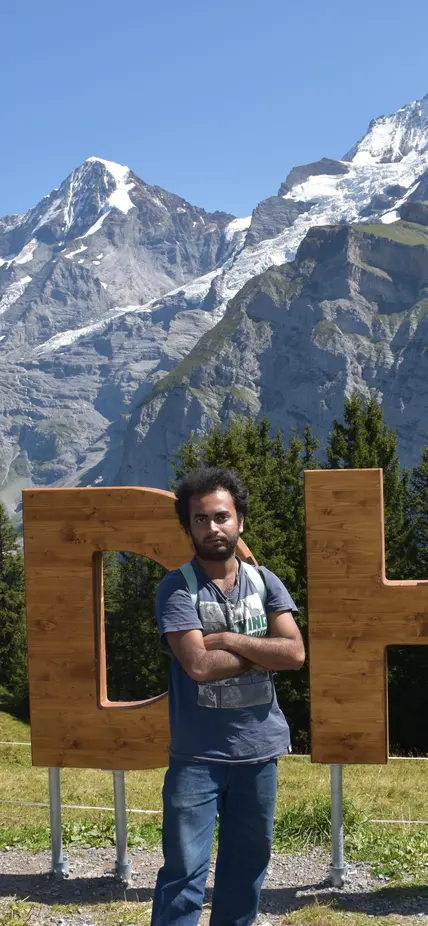We are living in a silicate world! 90% of Earth’s crust and 25% of all known minerals are silicates (e.g. minerals like quartz (SiO₂) that are composed of silicon and oxygen.) Given how much of our planet is made up of these minerals, figuring out how silicates change and interact with other materials inside planets is vital to understanding how our world formed, how it functions today, and how it may change in the future.
It’s impossible to study minerals in the deep Earth directly (unless they happen to get shuttled to the surface trapped inside of a diamond, but that’s another story). So, mineral physicists like Postdoctoral Fellow Rajkrishna Dutta put minerals through their paces in the lab.
Using EPL’s high-tech instrumentation to subject minerals to intense heat and pressure, Dutta pushes silicate minerals and their analogs through previously unexplored phase changes to understand the physics and chemistry going on inside Earth and other planets. Testing minerals in the lab allows scientists to piece together the puzzle of planetary formation and may even help explain the existence of life on Earth and other planets!
In this postdoc spotlight, Dutta explains his recent research, shares how he got into geology and mineralogy, and gives advice to current grad students.
(Interview edited for clarity)
What is your area of research and why do you think it is important?
I am a high-pressure mineral physicist. I am interested in exploring the behavior of materials under extreme conditions. I study the high-pressure temperature behavior of planetary silicates and their analogs to understand the structure and dynamics of these bodies.
Why do you think it's important to study minerals in extreme conditions?
A planet’s internal structure is controlled by the crystal chemistry of its constituent minerals. The phase relations and physical properties of minerals including viscosity, thermal conductivity, and melting behavior control processes such as dynamo formation and the emergence of plate tectonics—both of which are believed to be important for a planet's potential to harbor life. Understanding the physical and chemical properties of minerals will help us address these fundamental questions.
How did you choose to be a mineral physicist?
As a kid, I was always attracted to shiny gemstones and pretty rocks and minerals. As I grew up, I wanted to study geology because it is the closest thing to nature. I really enjoyed the mineralogy classes and did my master's thesis on computational mineralogy. Then I decided to try some hands-on experiments which led me to my Ph.D. and now a post-doc on experimental mineral physics.
What is a project you've been working on recently?
In recent work published this year, Staff Scientist Sally June Tracy and I worked on Mg2GeO4, an analog of the common upper mantle mineral olivine, Mg2SiO4.
As you go deeper into the Earth where pressure and temperature increase, silicate minerals transform from one phase to another. For example, what might start as olivine in the upper mantle will change to the mineral wadsleyite then ringwoodite as you move deeper into the planet, converting to a mixture of (Mg,Fe)O (magnesio-wustite) and a mineral with the crystal structure of orthorhombic perovskite, known as bridgmanite. The deepest silicate phase on Earth is post-perovskite—a high-pressure phase of magnesium silicate (MgSiO3). This mineral is prevalent in the D’’ layer—the lowermost portion of the mantle.
(Editors note: Post-perovskite does not have a mineral name because tradition requires the mineral be found in a natural occurrence before it can be named, yet post-perovskite, so far, has been produced only in the laboratory.)
However, in larger exoplanets, we expect further phase transitions. Current experimental advances cannot replicate the high pressure and temperatures of large planetary interiors, so we have to use analogs like Mg2GeO4 that we can test in the laboratory.
Using this silicate analog, we observed the first disordered, 8-coordinated silicate/ germanate phase. If this phase is also stable in the silicates, it has important implications like low thermal conductivity, mantle convection, and plate tectonics.
https://arxiv.org/abs/2101.00347
How has your background influenced your research?
As an undergrad, I majored in geology with a minor in physics. I think this lets me appreciate the advances in both condensed matter physics and solid earth geophysics and work at the interface of the two disciplines.
What else has influenced your thinking as a scientist?
My advisors. I have had advisors that always valued my ideas and helped me shape projects independently. I was always encouraged to lead and formulate project ideas rather than working on existing problems.
When you’re not actively researching, what hobbies or activities do you enjoy in your spare time?
Beyond academic research, I am passionate about travel and cooking. I am also an avid reader of suspense thrillers and science fiction books.
Why did you choose the Earth and Planets Laboratory?
The world-class scientists, state-of-the-art research facilities, friendly ambiance, and the location in Washington DC.
I have to ask, do you have a favorite mineral?
Amethyst, or quartz in general. I fell in love with it on a field trip to Jabalpur in India during undergrad. I was awed by the pretty geodes in Kentucky later in my grad school life. Cracking them open to find a world of mystery is so much fun!
What's next for your research?
I plan on delving deeper into my shock impact projects. We are looking at the amorphous to crystalline transition in germania glass using a two-stage gas gun facility at the Dynamic Compression Sector of the Advanced Photon Source.
Do you have any advice for current graduate students?
Read and be patient, read all that you can. We all have gone through times when experiments don’t work. Hang in there.
Please visit Rajkrishna Dutta’s website to learn more about his work and interests.



